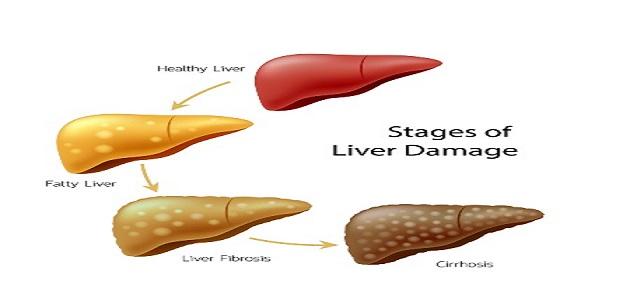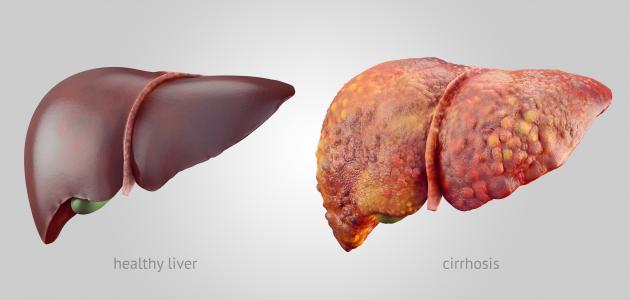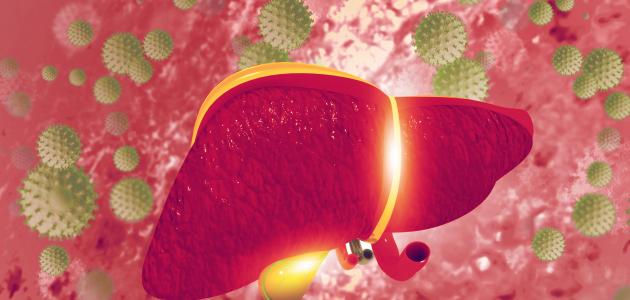Contents
- 1 liver cirrhosis
- 2 Symptoms of cirrhosis
- 2.1 Primary symptoms of cirrhosis
- 2.2 Symptoms and complications of advanced cirrhosis
- 2.2.1 Jaundice, itching, and discoloration of stool and urine
- 2.2.2 Ease of bleeding and bruising
- 2.2.3 Varicose veins
- 2.2.4 Fluid accumulation in the body and abdominal ascites
- 2.2.5 Pulmonary hypertension
- 2.2.6 Hepatic encephalopathy
- 2.2.7 Gallstones form
- 2.2.8 Spleen enlargement
- 2.2.9 Renal failure
- 3 References
Liver cirrhosis
Liver cirrhosis is an advanced stage of liver cirrhosis represented by the formation of scar tissue in the liver as a result of its exposure to some diseases and health conditions, [1]The liver usually has an intrinsic ability to repair and cure if its tissues are damaged. By regenerating damaged cells, which leads to the formation of scar tissue as a result of this repair, however, prolonged exposure to some factors that usually lead to damage to the liver: such as alcoholic drinks, fats, and some types of viral infections, may lead to the accumulation of scar tissue in the liver And disruption in its ability to repair cells and perform its functions normally, and thus liver cirrhosis, and in fact the liver is responsible for carrying out many necessary functions in the body: such as purifying the blood from many types of toxins and bacteria, fighting infection, and producing proteins. Responsible for blood clotting, in addition to the liver’s important role in absorbing and storing many nutrients: fats, vitamins, and sugars. [2] [3]
It should be noted that cirrhosis cannot usually be treated medically, and the patient needs to undergo a liver transplant, but if cirrhosis is discovered at an early stage, medical treatment can help prevent further damage to liver tissue, or even reverse it in some cases. [1]
To learn more about liver cirrhosis, read the following article: ( What is cirrhosis ) .
To learn more about the treatment of cirrhosis, read the following article: ( Treating cirrhosis ) .
Symptoms of cirrhosis
The symptoms associated with cirrhosis vary among people with different conditions, so often the patient does not show any symptoms or feel only some general symptoms, especially in the early stages of the infection, where the remaining healthy liver cells are usually able to fill the body’s need for liver function. As the degree of scarring in the liver tissues progresses, the liver loses its ability to perform its functions of purifying the blood, and toxins and some other substances accumulate in high and toxic concentrations, and the proportion of necessary substances and compounds made by the liver decreases, so severe symptoms and complications resulting from cirrhosis of the liver begin to appear on the patient as well, which needs care. Special medicinal products to control and relieve them. [1]
Symptoms of primary cirrhosis
The patient usually does not show clear symptoms at the beginning of cirrhosis, as mentioned above, and in some cases some general and non-specific symptoms and signs may appear; Meaning that it can accompany other diseases and health problems as well, and among the primary symptoms and signs of cirrhosis and cirrhosis are the following: [4] [5]
- Fatigue and tiredness.
- Nausea, loss of appetite and unexplained weight loss. [6]
- The appearance of small, red spider veins on the skin; Medically known as spider angioma. Which is the expansion of a group of small arteries clustered near the surface of the skin, which leads to their appearance in the form of a red spiderweb on the surface of the skin, and cirrhosis of the liver, especially cirrhosis resulting from alcohol consumption, is one of the causes of the appearance of a spider angioma; This can be attributed to the high level of estrogen in the body of a person with liver disease. [7]
Symptoms and complications of advanced cirrhosis
There are many symptoms and signs following the aforementioned initial symptoms, which often appear as a result of the progression of the degree of infection and the development of complications resulting from liver damage, and the following is an explanation of some of the most prominent complications of cirrhosis and cirrhosis: [5]
Jaundice, itching, and discoloration of stool and urine
A healthy liver deals with a pigment that is produced in the body and called bilirubin , to be disposed of appropriately. Jaundice, and the sufferer may notice some other signs and symptoms associated with jaundice: itchy skin, changes in the color of urine and stools, and the itching feeling associated with liver cirrhosis may be attributed to the accumulation of bile . ) In the skin layer, and it should be noted that the liver is responsible for the production of this substance that helps digest fats in the normal position. [8] [9] [10]
Ease of bleeding and bruising
Hepatic damage resulting from cirrhosis disrupts the liver's ability to produce the proteins responsible for the process of blood clotting , and thus this imbalance in blood clotting leads to easy bruising on the body and bleeding . [8] There are many symptoms and signs that the patient can infer from his injury, and some of them are listed below: [11]
- Epistaxis: means nosebleeds without a clear justified cause.
- Menorrhagia: means excessive or prolonged bleeding during the period of the menstrual cycle.
- Excessive bleeding after exposure to a minor wound: such as bleeding associated with some minor wounds, or after taking a blood sample, or after performing dental operations, or when brushing or flossing the teeth.
- The appearance of bruises on the skin: such as the appearance of red or purple spots or spots on the surface of the skin without a justifiable reason, and the expansion of some blood vessels may lead to their appearance on the skin or mucous membranes clearly.
Varicose veins
One of the most important complications of cirrhosis is portal hypertension . Which is represented by high blood pressure in the portal vein; It is the blood vessel that carries the blood coming from the digestive system to the liver, to be filtered through the liver cells, and then continue its way to the general bloodstream and the heart, and it is worth noting that scarring of the liver tissues in people with cirrhosis causes slowing and obstructing the passage of blood through the portal vein, so blood pressure rises In it, so that it may in turn lead to the backflow of blood in the veins connected to it, and thus to their swelling in what is known as varicose veins. These varicose veins usually appear in the lower part of the lining of the esophagus in what is known as Varices), or in the stomach in what is known as stomach varicose veins, and the risk in the event of infection lies with the possibility of rupture of the varicose veins and bleeding. [12] [13]
Fluid accumulation in the body and abdominal ascites
Cirrhosis leads to accumulation of fluid in the body, especially in the legs and abdomen area, and the accumulation of fluid in the abdomen is known medically as ascites, and it should be noted that cirrhosis is the main cause of abdominal ascites. Where studies have shown that it is the cause of 85% of cases of abdominal dropsy in the United States of America, and abdominal dropsy is the most common complication of cirrhosis of the liver, and the probability of developing it is estimated at 50% of cases of cirrhosis within 10 years of the initial diagnosis, and it should be noted that the associated abdominal dropsy Cirrhosis results from a decrease in the liver’s ability to produce the protein albumin and portal hypertension, which we mentioned earlier, [5] [14] [15]There are many signs and symptoms associated with abdominal ascites in addition to weight gain and flatulence , in the following statement of some of the most prominent: [16]
- Abdominal pain: The accumulation of fluid in the abdominal area causes the patient to feel discomfort and pain, in addition to difficulty breathing, and this can lead to a defect in the affected person's ability to eat, move, and carry out normal daily activities.
- Infection: A person with abdominal dropsy may feel some symptoms and signs such as a rise in body temperature, abdominal pain, and a feeling of nausea, which may indicate infection with bacterial peritonitis, and it can be detected from During an examination of a sample of the fluid collected in the abdominal area, treatment is usually done through intravenous antibiotics in addition to completing treatment with antibiotics to prevent the infection from reappearing. It should be noted the importance of direct treatment in the event of infection. This is because of its complications: kidney failure , transmission of infection to the bloodstream, and mental confusion .
- Hernia: : Abdominal dropsy can lead to an umbilical hernia in the area around the umbilicus or an inguinal hernia in the area between the thighs; As a result of increased pressure inside the abdomen.
- Fluid accumulation in the chest: The patient may experience difficulty breathing when moving or resting if fluid collects in the pulmonary cavity in what is known as Hepatic Hyrothorax, and it should be noted that in the event of this condition, the accumulation of fluid is usually On the right side of the lungs.
Pulmonary hypertension
Portal hypertension can lead to high blood pressure in the pulmonary arteries in what is known as Portopulmonary Hypertension, and this rise in blood pressure is usually accompanied by some symptoms and signs: such as difficulty breathing Heart failure, fatigue, and other symptoms similar to those of heart failure. [12]
Hepatic encephalopathy
The resulting damage to the liver leads to an imbalance in its ability to purify the blood from toxins, such as ammonia in the body, which leads to its accumulation in the body, and it is possible for these toxins to travel through the body to reach the brain, leading to a temporary imbalance in the brain's ability to carry out It functions normally in what is known as Hepatic Encephalopathy, which requires medical treatment to control symptoms and reduce the level of ammonia in the body. The following is a statement of some of the symptoms of hepatic encephalopathy: [17] [18]
- Confusion and lack of attention.
- Mood swings.
- Change in logical thinking, behavior, and personality.
- Sleep disturbances.
- Depression or irritability.
- Difficulty concentrating.
- The appearance of a musty smell when breathing.
- Trembling in the hands.
- Movement and speech disorders.
- Loss of consciousness or coma in the absence of treatment.
Formation of gallstones
In fact, gallstones are one of the complications that can affect people with cirrhosis. Often gallstones are not accompanied by symptoms or signs, but in some cases they may cause the sufferer to feel severe pain in the right side of the abdomen, the pain usually radiates to the back and lasts for 15-30 minutes, and it should be noted that the patient may feel pain after Eating food in some cases. [8] [19]
splenomegaly
The spleen works to purify the body of red and white blood cells, and platelets , and blood usually moves from the spleen to the portal vein, and in the event of high blood pressure in the portal vein as a result of infection with cirrhosis, this is It obstructs the exit of blood from the spleen and thus accumulates inside it, which may cause the splenomegaly to enlarge. It should be noted that this increase in the size of the spleen usually increases its work on filtering blood from cells and platelets, and thus to a decrease The number of these cells is less than the normal position, which may lead to anemia due to a decrease in red blood cells, or an increased possibility of infection due to a decrease in the number of white blood cells, or a defect in the body's ability to clot the blood due to a decrease in the number of platelets . [20]
Kidney failure
Cirrhosis of the liver, and its exposure to more damage over time, may cause kidney damage, and a lack of blood supply to it as a result of the disturbances caused by cirrhosis in the circulatory system, [21] and thus the possibility of an individual suffering from kidney failure in what is known as Hepatorenal Syndrome. This syndrome leads to an imbalance in the kidneys' ability to produce urine (Urine) and excrete it from the body, and thus to the accumulation of more toxins in the body. [12] [22]
References
- ^ A b t "Cirrhosis" , Www.mayoclinic.org , Retrieved 20-10-2019. Edited.
- ↑ "Cirrhosis" , www.healthline.com , Retrieved 8-9-2019. Edited.
- ↑ "Cirrhosis and Your Liver" , www.webmd.com , Retrieved 8-9-2019. Edited.
- ↑ "Chronic Liver Disease / Cirrhosis" , www.hopkinsmedicine.org , Retrieved 9-9-2019. Edited.
- ^ A b t "Cirrhosis" , Www.cedars-sinai.edu , Retrieved 9-9-2019. Edited.
- ↑ "Symptoms & Causes of Cirrhosis" , www.niddk.nih.gov , Retrieved 9-9-2019. Edited.
- ↑ "Spider Nevus (Spider Angiomas)" , www.healthline.com , Retrieved 9-10-2019. Edited.
- ^ A b v " the Common Complications Of Cirrhosis" , Www.verywellhealth.com , Retrieved 9-9-2019. Edited.
- ↑ "Liver cirrhosis" , www.mydr.com.au , Retrieved 9-10-2019. Edited.
- ↑ "Jaundice" , www.nhs.uk , Retrieved 9-10-2019. Edited.
- ↑ "Bruising and Bleeding" , www.msdmanuals.com , Retrieved 9-9-2019. Edited.
- ^ A b t "Cirrhosis Of The Liver" , Www.merckmanuals.com , Retrieved 21-10-2019. Edited.
- ↑ "Esophageal Varices" , www.health.harvard.edu , Retrieved 21-10-2019. Edited.
- ↑ "Pathogenesis of ascites in patients with cirrhosis" , www.uptodate.com , Retrieved 21-10-2019. Edited.
- ↑ "Ascites" , medlineplus.gov , Retrieved 25-10-2019. Edited.
- ↑ "Ascites: A Common Problem in People with Cirrhosis" , gi.org , Retrieved 10-21-2019. Edited.
- ↑ "Diagnosing Hepatic Encephalopathy" , liverfoundation.org , Retrieved 21-10-2019. Edited.
- ↑ "Hepatic Encephalopathy" , www.msdmanuals.com , Retrieved 21-1-2019 . Edited.
- ↑ "Gallstones in patients with liver cirrhosis: Incidence, etiology, clinical and therapeutical aspects" , www.ncbi.nlm.nih.gov , Retrieved 10-21-2019. Edited.
- ↑ "Cirrhosis (Liver)" , www.medicinenet.com , Retrieved 10-21-2019. Edited.
- ↑ "Hepatorenal syndrome" , www.uptodate.com , Retrieved 10-21-2019. Edited.
- ↑ "Hepatorenal syndrome" , medlineplus.gov , Retrieved 10-21-2019. Edited.





